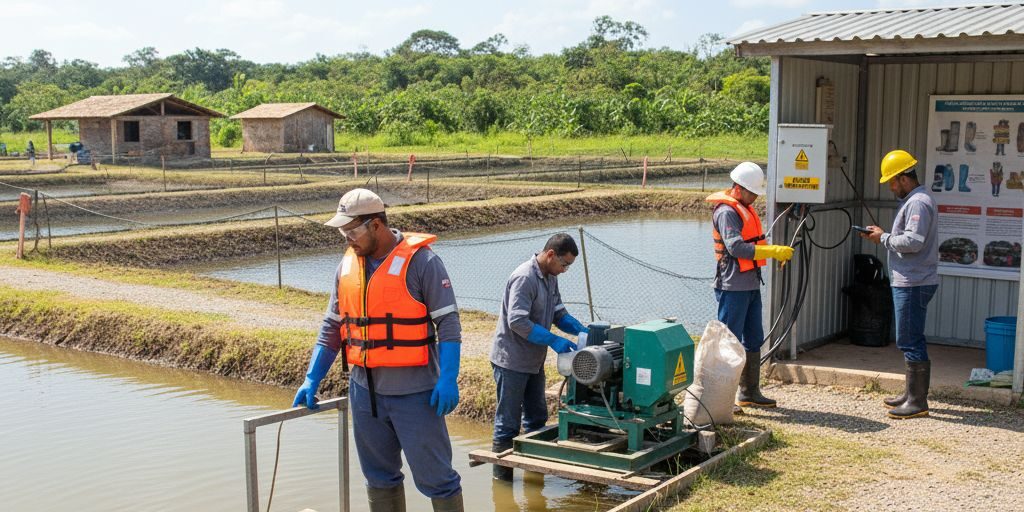- Software Gestor para Aquicultura
- (85) 2139-6730
- contato@despesca.com.br
Water Grant: Ensure the Legal Right to Use Water for Your Aquaculture Production in Brazil

How to Negotiate the Best Price at Harvest: Processors vs. Middlemen
24/09/2025
Aquaculture Waste Disposal: A Comprehensive Guide to Techniques and Utilization
26/09/2025Water is the most valuable resource for any shrimp or fish producer, forming the foundation of the entire operation. However, its use for commercial purposes, such as in aquaculture, is regulated by law in Brazil and requires a specific authorization from the public authorities. This instrument, known as a water grant (or outorga de água in Portuguese), is an administrative act that assures the producer the right to capture and use water from a river, lake, pond, or underground sources for a determined period, establishing the permitted conditions and volumes. Obtaining this license is not merely a bureaucratic formality; it is, above all, a guarantee of legal security for the enterprise and a pillar for the sustainable management of water resources within Brazil.
The Importance of the Water Grant for Business Sustainability
Many producers might view the water grant process as an obstacle, but, in reality, it functions as a protective mechanism. Firstly, by regularizing water usage, the aquaculturist avoids severe sanctions, such as heavy fines and even the interdiction of their activity, which can jeopardize their entire investment. Furthermore, the water grant is an indispensable requirement for obtaining other environmental licenses within Brazil and, consequently, for accessing rural credit lines and bank financing, which frequently demand proof of the project’s environmental regularity.
Additionally, the grant application process necessitates detailed planning of water usage on the farm. This leads to more efficient management, as the producer must accurately calculate their water demand, the capture flow rate, and the carrying capacity of the water body. As a result, more conscious management practices are encouraged, promoting the rational use of water and the long-term sustainability of production. Therefore, the water grant organizes the multiple uses of water, preventing conflicts between different users within the same hydrographic basin and ensuring that aquaculture develops in harmony with the environment and other economic activities in the region.
How Does the Water Grant Application Process Work in Brazil?
The process for applying for a water grant in Brazil varies slightly depending on whether the water body is under federal domain (rivers crossing more than one state) or state domain. In the former case, the application is made to the National Water and Basic Sanitation Agency (ANA). In the latter, the state water resources management body is responsible. Although the specifics may change, the general steps typically follow a pattern.
The initial step involves completing application forms and submitting a series of documents, which generally include:
- Personal or company documents: CPF/CNPJ (Brazilian tax IDs), RG (identity card), Articles of Incorporation.
- Proof of property ownership or use: Property deed or lease agreement.
- Detailed technical project: Prepared by a qualified professional (such as a Fisheries Engineer or Agronomist), containing information about the purpose of use, the capture flow rate, the cultivation system, the number of ponds or tanks, and the geographical coordinates of the capture point.
- Technical Responsibility Annotation (ART): A document that proves the technician’s responsibility for the submitted project.
Following submission, the competent body analyzes the documentation and the technical feasibility of the request, verifying water availability in the basin and the impact of the requested use. If approved, the grant act is published in the Official Gazette, formalizing the producer’s right to use the water.
Technology as an Ally in Management and Regularization
Maintaining control of all the data necessary for the grant process and for the continuous monitoring required by the license can be challenging. It is at this point that technology becomes an indispensable tool. The use of management software, such as Despesca, centralizes all production information, making the aquaculturist’s life easier.
With a management system, it is possible to record and organize crucial data such as the volume of water used, renewal rates, water quality parameters, and production data for each cycle. Having these detailed and accessible records not only simplifies the preparation of the technical project for the water grant application but also assists in complying with the conditions established in the license. In this way, the producer ensures the legal compliance of their enterprise, optimizes the use of water resources, and strengthens the foundation for increasingly professional and sustainable production.




